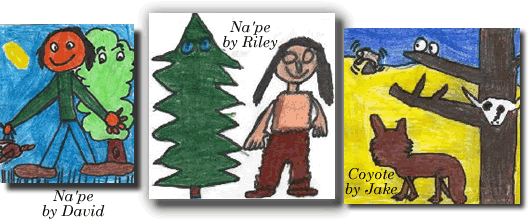|
|
Blackfoot Discoveries:
Blackfoot Stories: The Eyes of
A-pe-si

Our summary of The Eyes of A-pe-si told by:
Michael,David, Riley & Jake
One day Na'pe was traveling
over the land and he always had to watch out for his enemies. He was supposed
to climb up tall trees to check things out but he was too lazy. As he
was walking along he heard a bird say, "Eyes jump over to that tree"
and the eyes came out of the bird and landed on the top of a tree. Then
he asked his eyes to come back and they did. Na'pe thought this was a
fun thing to do and he wanted to do it too so he wouldn't have to climb
up the trees. So he asked the birds to teach him how to make his eyes
go out of his eye sockets. They taught Na'pe how to do it but told him
not to put his eyes up on the same tree more than 4 times or his eyes
wouldn't come back to his head. He also had to find a dead tree.
Na'pe did not listen to the
birds and put his eyes up the same tree 5 times because he was too lazy
to find a dead tree. His eyes wouldn't come back to him. Coyote was happy
to see Na'pe without eyes so he decided to trip him and scare him. Na'pe
got mad, grabbed Coyote and took Coyote's eyes out of his sockets and
put Coyote's eyes on him. Na'pe got gooseberries and put them in Coyote's
eyes so he could see again.
What did we hear in this story that we have heard in other stories?
- Na'pe is always tricking
animals.
- Na'pe doesn't listen or
obey. He always gets into trouble.
- Animals and nature talk
and help.
- There is always a problem
and a lesson to be learned.
- Na'pe is always traveling
or walking somewhere.
- To get attention Na'pe starts
to cry or yells.
- The number 4 is mentioned
We think the story teaches us..
- To do as you are told or
something could go wrong
- Not to annoy others or they
could hurt you
|

